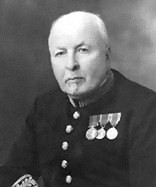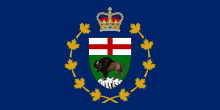Lieutenant Governor of Manitoba
| Lieutenant Governor of Manitoba | |
|---|---|
 Shield of the Lieutenant Governor | |
since 19 June 2015 | |
| Viceroy | |
| Style | Her Honour the Honourable |
| Residence | Government House, Winnipeg |
| Appointer | Governor General of Canada |
| Term length | At the Governor General's pleasure |
| Formation | 15 July 1870 |
| First holder | Sir Adams George Archibald |
| Website | www.lg.gov.mb.ca |

The Lieutenant Governor of Manitoba /lɛfˈtɛnənt/ is the viceregal representative in Manitoba of the Canadian monarch, King Charles III, who operates distinctly within the province but is also shared equally with the ten other jurisdictions of Canada, as well as the other Commonwealth realms and any subdivisions thereof, and resides predominantly in his oldest realm, the United Kingdom. The Lieutenant Governor of Manitoba is appointed in the same manner as the other provincial viceroys in Canada and is similarly tasked with carrying out most of the monarch's constitutional and ceremonial duties.[1] The present, and 25th, Lieutenant Governor of Manitoba is Janice Filmon, who has served in the role since 19 June 2015.[2]
Role and presence
The Lieutenant Governor of Manitoba is vested with a number of governmental duties and is also expected to undertake various ceremonial roles. The lieutenant governor, him or herself a member and Chancellor of the order,[3] will induct deserving individuals into the Order of Manitoba and, upon installation, automatically becomes a Knight or Dame of Justice and the Vice-Prior in Manitoba of the Most Venerable Order of the Hospital of Saint John of Jerusalem.[4] The viceroy further presents other provincial honours and decorations, as well as various awards that are named for and presented by the lieutenant governor; these are generally created in partnership with another government or charitable organization and linked specifically to their cause.[5] These honours are presented at official ceremonies, which count amongst hundreds of other engagements the lieutenant governor partakes in each year, either as host or guest of honour; in 2006, the Lieutenant Governor of Alberta undertook 334 engagements and 284 in 2007.[6]

At these events, the lieutenant governor's presence is marked by the lieutenant governor's standard, consisting of a blue field bearing the escutcheon of the Arms of His Majesty in Right of Manitoba surmounted by a crown and surrounded by ten gold maple leaves, symbolizing the ten provinces of Canada. Within Manitoba, the lieutenant governor also follows only the sovereign in the province's order of precedence, preceding even other members of the Canadian Royal Family and the Queen's federal representative.
History
The office of Lieutenant Governor of Manitoba came into being in 1870, upon Manitoba's entry into Canadian Confederation,[7] and evolved from the earlier position of Lieutenant Governor of the Northwest Territories, though the occupants continued to simultaneously act as Lieutenant Governors of the Northwest Territories and later as Lieutenant Governors of Keewatin District, until the latter was reabsorbed into the Northwest Territories in 1905. Since 1867, 24 lieutenant governors have served the province, amongst whom were notable firsts, such as Pearl McGonigal – the first female lieutenant governor of the province – and Yvon Dumont – the first Métis lieutenant governor. The shortest mandate by a Lieutenant Governor of Manitoba was Adams George Archibald, from August 1870 to October 1872, while the longest was Roland Fairbairn McWilliams, from 1 November 1940 to 1 August 1953.
In 1919, the Manitoba legislature voted in favour of The Initiative and Referendum Act, which sought to eliminate the lieutenant governor from the legislative process in the province. Royal Assent to the bill was reserved by Lieutenant Governor James Aikins and eventually the Judicial Committee of the Privy Council at Westminster ruled that, since the law affected an appointee of the federal Crown, it was ultra vires and struck down.[8][9]
Lieutenant Governor George Johnson was called upon to use his reserve powers in March 1988. The governing New Democratic Party (NDP) lost its thin majority in the legislature when one of its Members of the Legislative Assembly, Jim Walding, moved to an opposition party and voted along with the rest of the opposition against the proposed budget, a matter of confidence and supply. Johnson thereafter dissolved the legislature and called an election and the premier, Howard Pawley, announced his resignation both as premier and as leader of the NDP.[10] Pawley felt that he could "hand over the premiership" to whoever succeeded him as party leader.[11] Johnson, however, retained Pawley as premier, waiting until after the provincial election to appoint a successor, so that whomever was by then NDP leader could face and test the confidence of the legislature,[12] should the NDP even win. The NDP failed to win the election, regardless.
See also
References
- ^ Victoria (29 March 1867). "Constitution Act, 1867". V.58. Westminster: Queen's Printer. Retrieved 15 January 2009.
{{cite journal}}: Cite journal requires|journal=(help) - ^ Janice Filmon installed as Manitoba's lieutenant-governor, CBC News, June 19, 2015, retrieved June 19, 2015
- ^ Office of the Lieutenant Governor of Manitoba. "Awards > Order of Manitoba > Summary of Provisions". Queen's Printer for Manitoba. Retrieved 21 June 2009.
- ^ "Canada Wide > About Us > The Order of St. John > The Order of St. John in Canada". St. John Ambulance Canada. Retrieved 2 June 2009.
- ^ Office of the Lieutenant Governor of Manitoba. "Awards". Queen's Printer for Manitoba. Archived from the original on December 5, 2008. Retrieved 2 July 2009.
{{cite web}}: Unknown parameter|deadurl=ignored (|url-status=suggested) (help) - ^ Berezovsky, Eugene (2009). Staff of Canadian Monarchist News (ed.). $1.52 per Canadian: The Cost of Canada's Constitutional Monarchy (PDF) (4 ed.). Toronto: Monarchist League of Canada. p. 3. Retrieved 15 May 2009.
- ^ Victoria (12 May 1870). "Manitoba Act, 1870". 6. Westminster: Queen's Printer. Retrieved 16 June 2009.
{{cite journal}}: Cite journal requires|journal=(help) - ^ Webber, Jeremy (1997). "The Legality of a Unilateral Declaration of Independence under Canadian Law" (PDF). The McGill Law Journal. 42 (2). Montreal: McGill University: 290. Retrieved 3 March 2011.
- ^ Rose, John Holland (1940). The Cambridge history of the British Empire: The Growth of the new Empire, 1783-1870. Vol. 2. Cambridge: Cambridge University Press. p. 688.
- ^ Donovan, Davis S. (27 May 2009), The Governor General and Lieutenant Governors: Canada's Misunderstood Viceroys (PDF), Canadian Political Science Association, p. 9, retrieved 22 October 2012
{{citation}}: Invalid|ref=harv(help) - ^ Boyce, Peter (2008). The Queen's Other Realms: The Crown and its Legacy in Australia, Canada and New Zealand. Leichhardt: The Federation Press. p. 105. ISBN 978-1862877009.
- ^ Donovan 2009, p. 10
